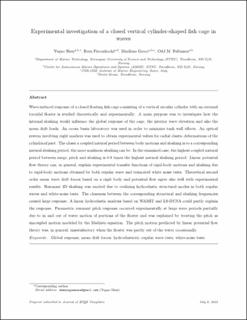| dc.contributor.author | Shen, Yugao | |
| dc.contributor.author | Firoozkoohi, Reza | |
| dc.contributor.author | Greco, Marilena | |
| dc.contributor.author | Faltinsen, Odd Magnus | |
| dc.date.accessioned | 2022-03-09T13:35:39Z | |
| dc.date.available | 2022-03-09T13:35:39Z | |
| dc.date.created | 2021-08-12T10:12:19Z | |
| dc.date.issued | 2021 | |
| dc.identifier.citation | Ocean Engineering. 2021, 236 . | en_US |
| dc.identifier.issn | 0029-8018 | |
| dc.identifier.uri | https://hdl.handle.net/11250/2984063 | |
| dc.description.abstract | Wave-induced response of a closed floating fish cage consisting of a vertical circular cylinder with an external toroidal floater is studied theoretically and experimentally. A main purpose was to investigate how the internal sloshing would influence the global response of the cage, the interior wave elevation and also the mean drift loads. An ocean basin laboratory was used in order to minimize tank wall effects. An optical system involving eight markers was used to obtain experimental values for radial elastic deformations of the cylindrical part. The closer a coupled natural period between body motions and sloshing is to a corresponding natural sloshing period, the more nonlinear sloshing can be. In the examined case, the highest coupled natural period between surge, pitch and sloshing is 0.8 times the highest natural sloshing period. Linear potential flow theory can, in general, explain experimental transfer functions of rigid-body motions and sloshing due to rigid-body motions obtained by both regular wave and truncated white noise tests. Theoretical second order mean wave drift forces based on a rigid body and potential flow agree also well with experimental results. Resonant 3D sloshing was excited due to ovalizing hydroelastic structural modes in both regular waves and white-noise tests. The closeness between the corresponding structural and sloshing frequencies caused large response. A linear hydroelastic analysis based on WAMIT and LS-DYNA could partly explain the response. Parametric resonant pitch response occurred experimentally at large wave periods partially due to in and out of water motion of portions of the floater and was explained by treating the pitch as uncoupled motion modeled by the Mathieu equation. The pitch motion predicted by linear potential flow theory was, in general, unsatisfactory when the floater was partly out of the water occasionally. | en_US |
| dc.language.iso | eng | en_US |
| dc.publisher | Elsevier | en_US |
| dc.rights | Attribution-NonCommercial-NoDerivatives 4.0 Internasjonal | * |
| dc.rights.uri | http://creativecommons.org/licenses/by-nc-nd/4.0/deed.no | * |
| dc.title | Experimental investigation of a closed vertical cylinder-shaped fish cage in waves | en_US |
| dc.type | Peer reviewed | en_US |
| dc.type | Journal article | en_US |
| dc.description.version | acceptedVersion | en_US |
| dc.rights.holder | This is the authors' accepted manuscript to an article published by Elsevier. Locked until 14.7.2023 due to copyright restrictions. | en_US |
| dc.source.pagenumber | 17 | en_US |
| dc.source.volume | 236 | en_US |
| dc.source.journal | Ocean Engineering | en_US |
| dc.identifier.doi | 10.1016/j.oceaneng.2021.109444 | |
| dc.identifier.cristin | 1925485 | |
| dc.relation.project | Norges forskningsråd: 268402 | en_US |
| dc.relation.project | Norges forskningsråd: 223254 | en_US |
| cristin.ispublished | true | |
| cristin.fulltext | postprint | |
| cristin.qualitycode | 1 | |

